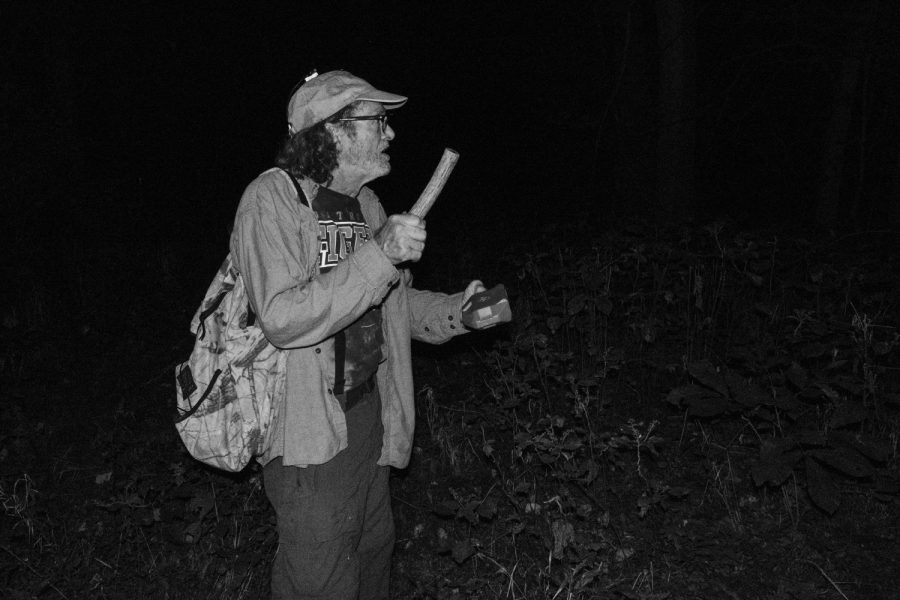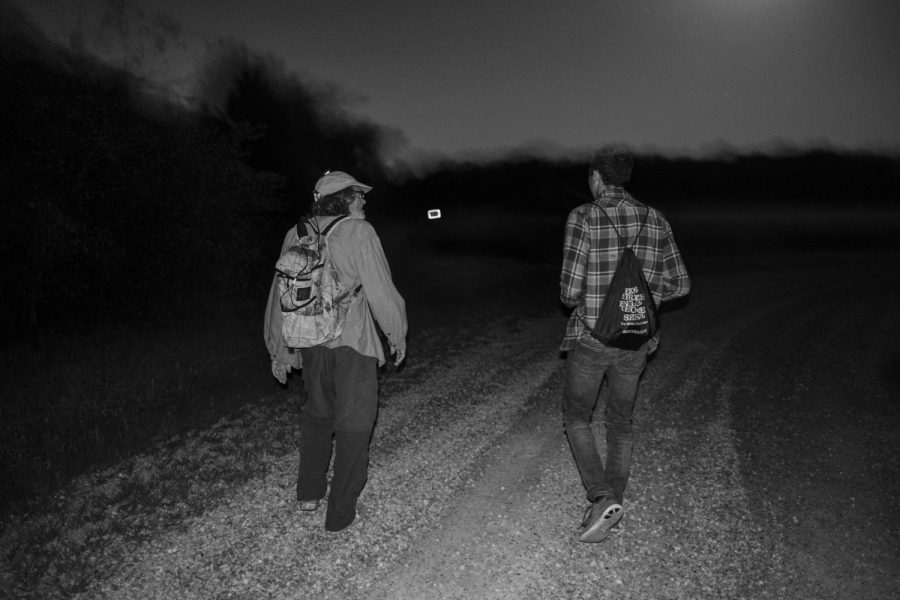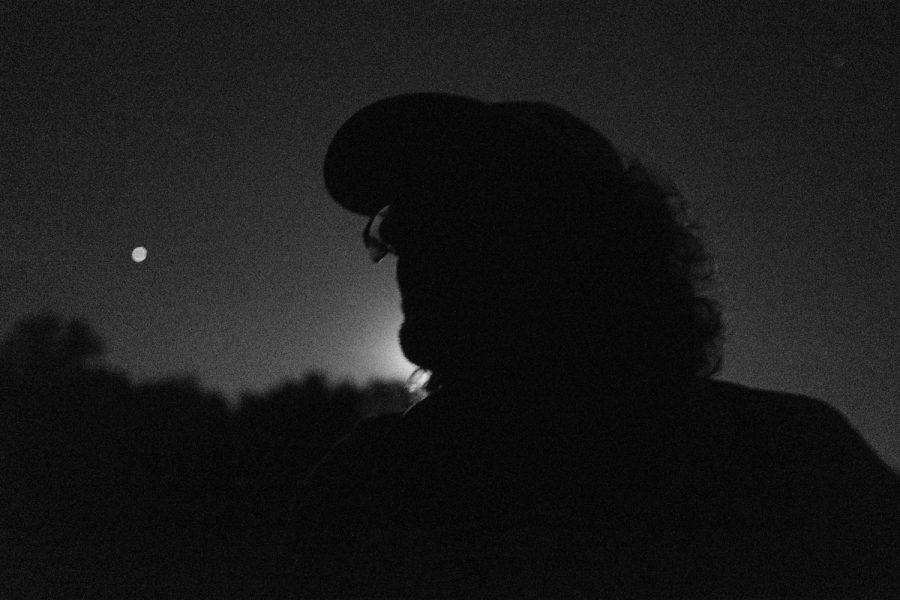The hunt to prove the existence of Sasquatch
Bigfoot researcher and believer searches for proof of Bigfoot’s existence in Iowa.

Steve Moon of the Lowlands Bigfoot Research Group simulates a Sasquatch’s wood knock in a wooded area near the Cedar River on Sept. 17. Moon said Sasquatches communicate through wood knocks made by clicking their tongues or knocking branches or logs against trees and rocks. Moon uses print casting, photography, and audio recording to research Bigfoot.
It is a pitch-black night with only a slight sliver of moonlight seeping through the thick branches of surrounding trees. The air feels almost alive, hazy and thick with the breath of nature. The ground is damp, the humidity unbearable. Mosquitoes and other insects buzz around, attacking the invasive strangers of this no-man’s land.
The sound of broken branches and twigs cracks through the night. There is a muffled cry in the distance.
This is the life of retired librarian and Bigfoot researcher Steve Moon, who founded the nonprofit Lowlands Bigfoot Research Group in 2017.
“There are a lot of little groups around the country who are looking into this problem of [ancient] hominids, but there aren’t too many that are doing scientific research,” he said.
With three M.F.A.s and a master’s in anthropology, Moon has studied Bigfoot for the past 10 years, and he claims to have had at least 12 sightings.
“This, to me, is a culmination of years of research and work,” he said. “Hopefully, it’ll lead to something real significant.”

Throughout the years, Moon said, he has observed Bigfoot’s unique behavior.
“We might hear a tree branch being broken, something thrown at us; they do that,” Moon said. “It’s a bluff, you know. They’ve never hit us with anything. They can act tough, but to the best of our knowledge, they’ve never hurt anyone. They’re not dangerous. In fact, they can be benevolent creatures.”
As do others, Moon said he implements the scientific method to study Bigfoot.
“It’s important,” Moon said. “If you want credibility to build theories, if you want to test, if you want to actually discover things, then you’ve got to follow that method,”
He has also said he no longer relies on other people’s stories for his research.
“Those are not really reliable data, and they’re not really something we can use, so we can’t do theory-building with it,” Moon said.
He said his ultimate goal is to prove Bigfoot’s existence so the species may be appreciated and preserved.
“We know that he exists, but now we need to find a way for science to accept that data,” he said. “The discovery has been made, but the discovery hasn’t been officially accepted, and until there’s that acceptance of the discovery, things are kind of at a standstill.”
Besides research, Lowlands Bigfoot is also starting educational programs for children in an attempt to get them outdoors. Having them involved in the process of discovery and the joy of the unknown is one of the main goals.
“That process is really fulfilling, and so we want to share that with kids,” Moon said. “It’ll be a way for them to really find themselves and discover something.”

To get a more detailed look at his research, I, along with a photographer, accompanied Moon on a night operation. We drove down to a greenbelt area on the west side of the Cedar River, around 40 minutes east of Iowa City.
We followed a trail a little way, stopped, and just listened. Time seemed to slow as we stood there, waiting. I heard the hoot of a few owls and the crack of broken twigs, but nothing too significant.
However, every sound caused me to jump a little and lock my eyes in that direction.
We had hiked a bit farther when Moon decided to perform a wood knock. He described that as a way to catch Bigfoot’s attention; it is performed by hitting together a percussion instrument and a piece of Osage Orange wood. A few seconds after the wood knock, I heard what sounded like a distant echo. However, there was nothing I could see for the sound to bounce off of.
On our way back, Moon mimicked a Bigfoot’s howl. I could not hear a response, though Moon claims he did.
He recorded our trip. After analyzing the recording, he said, it had picked up the echo I heard.
“The knock sounds very much like my own, but in a slightly higher tone. The response isn’t a thunk or other knock sound but a ringing knock like mine,” Moon said. “We think they may sometimes produce these sounds with their tongues. Like a mouth pop. I think it’s the only way they would be able to produce an immediate response like that and make it sound like the knock they are responding to.”

Moon’s recorder also picked up a faint animal-like sound after his howl. I have listened to the recording, and though it is almost inaudible, I can verify there is something there.
“I may have gotten a response. It’s two seconds after my call ends. It’s descending, followed by a percussive ascending note,” Moon said. “If I were going to interpret this possible response, it sounds like a Sasquatch was offended by my call.”
Nothing could be more awful than the abundance of mosquito bites I received, but it is spooky to imagine that such a creature could have been out in the woods with us that night.
“We clearly got a response,” Moon said. “We were in the company of Sasquatch last night.”


